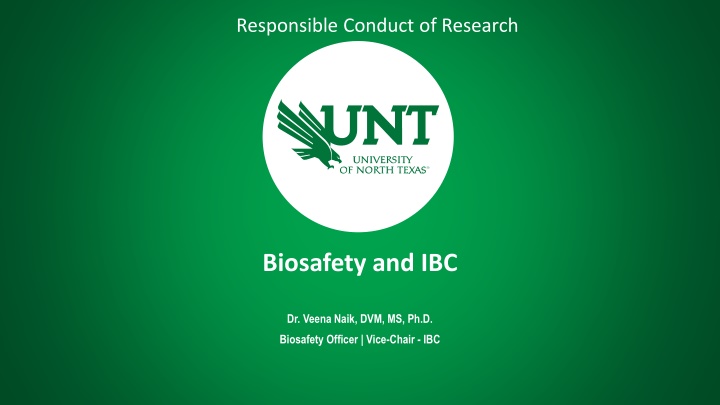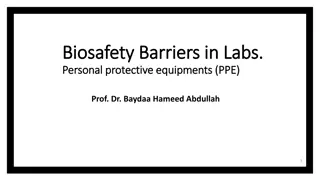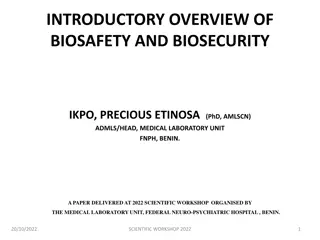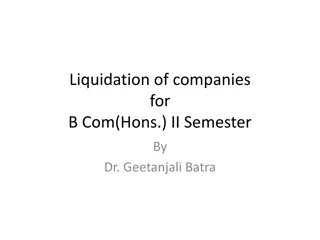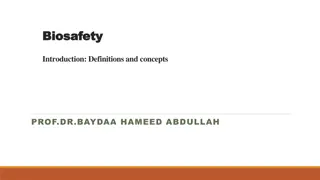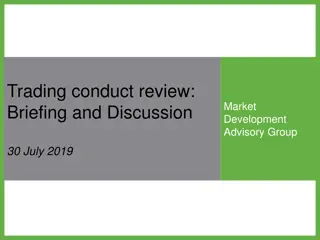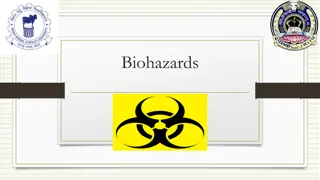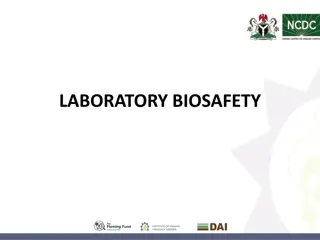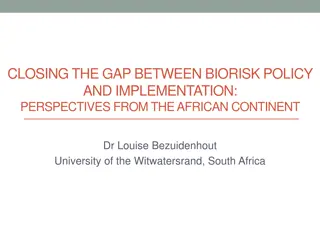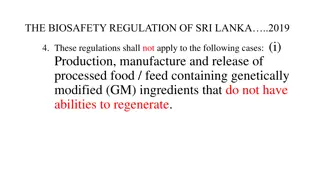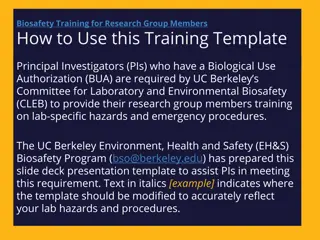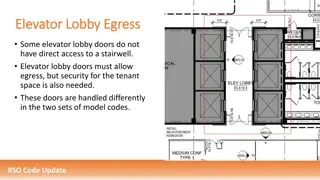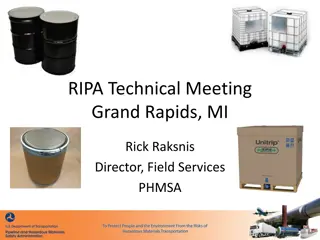Biosafety and IBC - Understanding Research Conduct and Safety Measures
Explore the essential aspects of biosafety and the role of Institutional Biosafety Committees (IBC) in ensuring responsible research conduct. Learn about biohazards, biosecurity, laboratory-acquired infections, routes of exposure, and the structure and functions of the IBC. Enhance your understanding of safety practices and protocols in research settings to safeguard researchers, communities, and the environment.
Download Presentation

Please find below an Image/Link to download the presentation.
The content on the website is provided AS IS for your information and personal use only. It may not be sold, licensed, or shared on other websites without obtaining consent from the author.If you encounter any issues during the download, it is possible that the publisher has removed the file from their server.
You are allowed to download the files provided on this website for personal or commercial use, subject to the condition that they are used lawfully. All files are the property of their respective owners.
The content on the website is provided AS IS for your information and personal use only. It may not be sold, licensed, or shared on other websites without obtaining consent from the author.
E N D
Presentation Transcript
Responsible Conduct of Research Biosafety and IBC Dr. Veena Naik, DVM, MS, Ph.D. Biosafety Officer | Vice-Chair - IBC
1 Biohazard Biohazards include biological agents and toxins that have the potential to cause disease in humans, animals, plants and can cause significant damage to the environment. (e.g. - parasites, viruses, bacteria, fungi, prions; and biologically- active materials such as toxins, allergens, and venoms) Biosafety Framework that describes the use of specific practices, training, safety equipment, and specially designed buildings to contain and protect the researchers, community, and environment from an accidental exposure or unintentional release of infectious agents and toxins. 2 3 Biosecurity Ensures the safe use and security of biological materials in laboratories. Biosecurity focuses on protecting biological agents from theft, loss, or misuse.
Laboratory acquired Infection Laboratory acquired infections (LAIs) are defined as all infections acquired through laboratory or laboratory- related activities. The risk of Laboratory-Acquired Infection (LAI) in employees of clinical and research laboratories are greater than what is seen in the general population. Left eye and right ear of a man with laboratory-acquired vaccinia virus infection --- Virginia, 2008
Routes OF Exposure Contact with skin and mucous membrane Splashes Contact with contaminated fomites Entry through broken/ cracked skin Ingestion Splashing to the face, placing contaminated objects in mouth, Eating/drinking in the space Inoculation Needlestick Laceration from sharp objects (injury due to blades, scissors, broken glass) Animal bite and scratch Inhalation Procedures that produce aerosols (pipetting, mixing, sonication changing cages, allergens )
The Institutional Biosafety Committee (IBC): What Why Who The IBC must have at least five voting members of specific backgrounds (subject matter experts in recombinant DNA, microbiologist, Animal and Plant research) to provide complete and adequate review of biohazards and its risk. Compliance with the NIH Guidelines is mandatory as a condition of receiving NIH funding for such research. Responsible for reviewing, approving and overseeing research involving the use of recombinant or synthetic DNA/RNA and other biohazards including animals of zoonotic importance in research and teaching labs. And to promote the safe conduct of research involving biohazardous materials. The Committee also includes at least two member from the local community, who is not affiliated with the institution. This includes field studies that are performed by UNT faculty, staff, or students off campus.
IBC Purview Since the IBC responsibilities need not be restricted to recombinant research , UNT IBC also reviews projects on: IBCs are typically assigned additional review responsibilities Risk Group 1 and above pathogens Animals or animal derived research materials Human derived samples Xenotransplantation Stem cell research Nanotechnology research Select agents and toxins Infectious agents, Biotoxins, or select agents Human tissue, blood, or most body fluids Animal tissues, organs, body fluids or Live/dead animals that carry zoonotic diseases Select Agents and Toxins Nanotechnology
Biosafety Levels at UNT BSL should be based on the hazardous agent(s) and manipulations of the agent that you will perform. Labs at UNT |7
UNT Required Training All Biosafety related training is now available via CITI Animal Biosafety (if working with animals) Initial Biosafety Training Personal Protective Equipment OSHA Bloodborne Pathogens (if working with human derived samples) NIH Recombinant DNA Guidelines (if working with recombinant DNA materials) Nanotechnology (if working with nano materials) USDA Permits Emergency and Incident Response to Biohazard Spills and Releases Biosafety Retraining (Annual Retraining) Laboratory Specific Training - PI Develop and Follow Standard Operating Procedure (SOP) - PI
Protocol Review All new protocols are reviewed by the entire committee. The committee meets on the 2nd Wed of each month. All approved protocols are valid for 3 years. Approved with contingency(s) Rejected Approved Tabled Moderate concerns raised or concerns requiring further clarification. Protocol not modified as suggested by IBC Significant concerned raised with key components of proposed research (e.g., BSL3 level work in BSL2 lab) Committee has no concerns regarding the protocol Few or minor issues with the protocol. Committee proposes conditions necessary for approval PI makes suggested changes in writing., resubmits to BSO/Chair PI must modify protocol and resubmit for full committee review at next meeting. Work may begin immediately Then work may begin No work may begin No work may begin, and resubmission of the protocol is not allowed. Changes to the approved protocol must be submitted via an IBC Amendment Form. Annual Renewal Form must be submitted to indicate that the project will continue
IBC: Scope of Review - Animal Research IACUC Review IBC Review ensures Research for conformity with the NIH Guidelines (ABSL1 and 2) Ways to mitigate/control risk to personnel, UNT Community and environment Animal welfare Pain and distress (behavioral, anatomical and physiological abnormalities) Adequacy of facilities, SOPs Risks to other animals in the facility from the inadvertent spread of vectors PI and other personnel training Risks to the environment Escape and establishment in the wild Interbreeding with wild stock Consumption by other animals enter the food chain Research involving animal tissues/organs/body fluids of zoonotic importance Scientific Merit and the three R |10
IBC: Scope of Review - Human Subject Research IRB Review IBC Review ensures Research for conformity with the NIH Guidelines, including gene therapy (2019) Conducts risk/benefit assessment relative to individual research participants (physical, psychological, social harms) Potential risk to individual researcher/lab members, health care workers, and the community Selection of subjects and the informed consent process Adequacy of facilities (BSL 2 and above) Provisions to protect subject privacy and confidentiality of data PI and other personnel training Institutional and investigator compliance (e.g., adverse event reports) Injuries or any other unanticipated problems Compliance with regulations Research involving fresh/frozen - tissues/organs/body fluids from vendors (ATCC) |11
Resources NIH - The NIH Guidelines for Research Involving Recombinant or Synthetic Nucleic Acid Molecules (2019) BMBL - Biosafety in Microbiological and Biomedical Laboratories (BMBL) 5th Edition (CDC/NIH) WHO - World Health Organization Laboratory Biosafety Manual Third Edition (WHO) CDC - Guidelines for Safe Work Practices in Human and Animal Medical Diagnostic Laboratories (CDC) UNT Policy - https://research.unt.edu/research- services/research-integrity-and-compliance OSHA regulations - https://www.osha.gov/laws- regs/regulations/standardnumber/1910/1910.1030 |12
Support Support/ Questions IBC Veena Naik IBCprogram@unt.edu | veena.naik@unt.edu Thank you!
